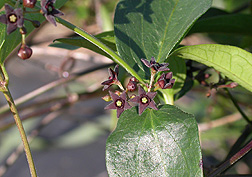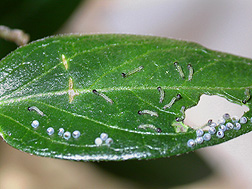Understanding and Controlling Two Invasive Vines
|
|
Even the name sounds threatening. Known as “dog-strangling vines” in Canada, European swallowworts are invasive vines that can grow to 8 feet in length and wrap around supporting vegetation and smother it. There are two species, pale swallowwort (Vincetoxicum rossicum) and black swallowwort (V. nigrum), and both will colonize disturbed soils and infest nurseries.
Both species have pushed onto pastures and are encroaching on the habitats of threatened and endangered species in New England and New York and of distinctive, prairie-like vegetation around the Great Lakes. Pale swallowwort also may harm forest regeneration. Both have been in the United States since the 1800s but have been expanding rapidly since the 1970s and are now found in Canada and at least 21 states from New England to Maryland and west to Kansas and Nebraska.
Lindsey Milbrath, an Agricultural Research Service entomologist with the Biological Integrated Pest Management Research Unit in Ithaca, New York, is working with ARS and university colleagues in Ithaca; Urbana, Illinois; and Fort Detrick, Maryland, and with partners overseas to try to curb the threat these two weed species pose to nurseries, Christmas tree farms, pastures, and natural areas.
The researchers are evaluating several potential biocontrols and searching for the biological mechanisms that make European swallowworts such dogged threats. “We’re looking for weak links that we could somehow exploit to control them,” Milbrath says.
Why Are They So Successful?
Research has shown that the reddish-flowered pale swallowwort grows rapidly in fields and forest edges but also invades understories, whereas the purple-flowered black swallowwort prefers habitats with more daylight. Pale swallowwort is from Russia and Ukraine, and black swallowwort is from southwestern Europe. Both have tenacious roots and buds that send out new shoots when surface growth is pulled up or mowed.
In one study, the researchers identified a mechanism that swallowworts might be using to colonize an area. Previous research suggested that pale swallowworts might be putting phytotoxins into the soil to discourage the growth of competing plants nearby—a process known as “allelopathy.” But the specific compounds responsible for pale swallowwort’s toxic effects had not been identified. The researchers wanted to determine whether both swallowwort species use a similar allelopathic strategy in displacing native plants.
Plant physiologist Donna Gibson and her colleagues at the ARS unit at Ithaca analyzed extracts from roots, leaves, seeds, and shoots from pale and black swallowworts. Their previous work showed that the roots of pale swallowwort contain antofine, a compound believed to have some antifungal, antibacterial, and cytotoxic properties. With the help of high-performance liquid chromatography, they found that both pale and black swallowworts contain antofine not only in roots, but also in shoots, leaves, and seeds. The results suggest that antofine may be one key to the vines’ ability to colonize an area.
In further experiments, they exposed lettuce seedlings to a variety of swallowwort extracts and found that one of the extracts, which contained antofine, inhibited growth of lettuce roots. They subsequently found that antofine strongly inhibited growth of three plants known to share swallowwort habitat in North America—common milkweed, butterfly milkweed, and Indianhemp—while having no effect on either swallowwort. The effects were not as pronounced for extracts made from black swallowwort, which generally contained lower concentrations of antofine. Results were published in the Journal of Chemical Ecology (2011).
|
|
The Search for Biocontrols
In their native ranges, European swallowworts are kept in check by natural enemies, particularly insects and diseases. So far, nothing in North America has halted their advance, and while eradication is no longer feasible, the researchers hope to find a biocontrol to reduce swallowwort populations.
“Even with a highly successful program, the plant will always be around, just at a much lower density. Eradication is only feasible with a small, localized infestation,” Milbrath says.
The scientists have narrowed down the list of potential biocontrols from more than nine original candidates to four—two fungi and two moths that, as caterpillars, feed on related species of swallowworts. One of the moths, Abrostola clarissa, was found in Russia with help from collaborators at the Zoological Institute of the Russian Academy of Sciences in St. Petersburg. The other moth, A. asclepiadis, was collected in France with help from collaborators at the ARS European Biological Control Laboratory in Montpellier.The moths are currently the focus of continuing studies by Milbrath and by scientists overseas. Among the challenges facing scientists is breeding disease-free moths for further testing.
|
|
“We need to have moths that are pathogen free to properly understand what plants they will or won’t feed on. A diseased moth may not behave normally,” Milbrath says.
One of the fungi being evaluated was found by a park naturalist in rural Monroe County, New York, who noticed an unusual dying off of a pale swallowwort population. The naturalist contacted Gibson, who collected samples and cultured them in her laboratory. By comparing its DNA with known samples, she identified it as Sclerotium rolfsii. She and her colleagues then used the fungus to inoculate sterilized seedlings of black and pale swallowwort in growth chambers.
“It shows promise, but we need to do more research to evaluate the host range of this isolate before we could consider the possibility of its use,” Gibson says. Results were reported in Plant Disease (2012).
The other fungus, Colletotrichum lineola, was found on a related species of swallowwort, V. scandens, in Russia. ARS plant pathologist Dana Berner, who discovered it with help from his Russian partners, brought it back under quarantine conditions to the ARS Foreign Disease-Weed Science Research Unit, in Fort Detrick, which is equipped with a secure BSL-3 containment facility that prevents the escape of any pathogens being evaluated. In a preliminary study, he cultured the fungus and used it to successfully inoculate seedlings of V. scandens, along with seedlings of black and pale swallowworts, under controlled conditions. After growing for 2 weeks in a quarantined greenhouse, all three swallowwort species developed symptomatic dark-red and purple spots on their leaves. Berner reported his findings in Plant Disease (2011).
Before any biocontrol can be released, however, it must undergo extensive testing and clear a number of regulatory hurdles designed to protect the plants that share the swallowworts’ habitats in North America. That process can take several years. But Milbrath is confident that the efforts will pay off and that researchers will find a way to reduce the threat that the two European swallowworts pose to agriculture and wildlife habitats.—By Dennis O'Brien, Agricultural Research Service Information Staff.
This research is part of Crop Protection and Quarantine, an ARS national program (#304) described at www.nps.ars.usda.gov.
To reach scientists featured in this article, contact Dennis O’Brien, USDA-ARS Information Staff, 5601 Sunnyside Ave., Beltsville, MD 20705-5128; (301) 504-1624.
"Understanding and Controlling Two Invasive Vines" was published in the September 2013 issue of Agricultural Research magazine.











